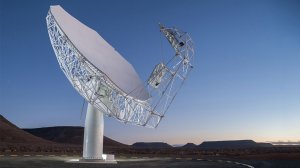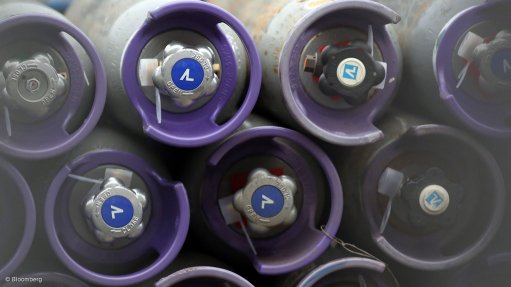MeerKAT radio telescope dishes also to be fitted with German receivers
Germany’s Max-Planck-Society (MPG) and the Max Planck Institute for Radio Astronomy (MPlfR) are investing €11-million (about R150-million) into South Africa’s MeerKAT radio telescope array programme. The money will be used to design, build and install S-band radio wave receivers on MeerKAT’s dishes. (The S-band covers radio frequencies between 2 GHz and 4 Ghz.)
“It’s a significant investment,” affirms SKA South Africa site bid manager Dr Adrian Tiplady. “It’s a significant statement by Germany: they have confidence in the MeerKAT telescope and are investing in radio astronomy in South Africa. The extra receivers will increase the amount of science that can be done by MeerKAT. As a result, it will increase demand by the international and local communities to conduct world-class science on the telescope. We are happy that a South African-designed and -funded instrument is now attracting international investment.”
The MeerKAT, when finished, will be composed of 64 dishes, each with an effective diameter of 13.5 m. Each dish will be fitted with a carousel able to accommodate multiple receivers. “Different receivers increase the different kinds of science that you can do,” he explains. “They open up the usable radio frequency spectrum. We specifically designed the dishes to ensure that they would have long upgrade paths, capable of hosting suites of different receivers.” Each dish will now be fitted with three receivers – two South African, the other German, and each dish will have room for more in the future.
The German receivers will be mainly used to study pulsars. These are rapidly spinning neutron stars which emit incredibly regular radio pulses. They can thus be used as very accurate clocks to test extreme physics. The South African receivers will operate in the L-band (1 GHz to 2 Ghz) and in the UHF-band (ultrahigh frequency: 580 MHz to 1.05 GHz).
MeerKAT is intended both as a major scientific instrument in its own right and as a precursor to the giant international Square Kilometre Array (SKA) radio telescope, which will be cohosted by South Africa and Australia (with a number of outstations in several other countries). MeerKAT will, in due course, be incorporated into Phase 1 of the SKA. MeerKAT, and the core of the South African part of the SKA, will be located in the Karoo region in the Northern Cape province, some 90 km west of the small town of Carnarvon.
The programme is progressing satisfactorily. By the end of this financial year (2014/15), four of the MeerKAT dishes should have been erected and should be undergoing tests, although not scientifically operational. (The first MeerKAT antenna was officially launched in March.) “MeerKAT will come into service in phases,” points out Tiplady. “It’s going to be a very phased process. We will start early science before all 64 dishes are commissioned. We’ll do the same thing with the SKA.”
Announcing the investment for the MeerKAT receivers, MPG president Martin Stratmann observed: “[W]e consider MeerKAT to be an important undertaking as it is not only a pre-eminent astronomy project, but also a lighthouse project for science in Africa in general. The MPG is very pleased to enable close collaboration between its scientists and the South African community and looks forward to seeing MeerKAT’s first glimpse of the universe with the receivers of the MPlfR.”
“MeerKAT is already acclaimed internationally as a world-class instrument – thanks to our partnership with Max Planck, MeerKAT’s ability to perform transformational science for the benefit of global knowledge production will be considerably boosted,” says South African Science and Technology Minister Naledi Pandor, welcoming the MPG’s decision to invest in the array. “Awaiting the start of construction of the SKA, South Africa and our international partners such as Max Planck continue to set the pace for global radio astronomy.”
Comments
Press Office
Announcements
What's On
Subscribe to improve your user experience...
Option 1 (equivalent of R125 a month):
Receive a weekly copy of Creamer Media's Engineering News & Mining Weekly magazine
(print copy for those in South Africa and e-magazine for those outside of South Africa)
Receive daily email newsletters
Access to full search results
Access archive of magazine back copies
Access to Projects in Progress
Access to ONE Research Report of your choice in PDF format
Option 2 (equivalent of R375 a month):
All benefits from Option 1
PLUS
Access to Creamer Media's Research Channel Africa for ALL Research Reports, in PDF format, on various industrial and mining sectors
including Electricity; Water; Energy Transition; Hydrogen; Roads, Rail and Ports; Coal; Gold; Platinum; Battery Metals; etc.
Already a subscriber?
Forgotten your password?
Receive weekly copy of Creamer Media's Engineering News & Mining Weekly magazine (print copy for those in South Africa and e-magazine for those outside of South Africa)
➕
Recieve daily email newsletters
➕
Access to full search results
➕
Access archive of magazine back copies
➕
Access to Projects in Progress
➕
Access to ONE Research Report of your choice in PDF format
RESEARCH CHANNEL AFRICA
R4500 (equivalent of R375 a month)
SUBSCRIBEAll benefits from Option 1
➕
Access to Creamer Media's Research Channel Africa for ALL Research Reports on various industrial and mining sectors, in PDF format, including on:
Electricity
➕
Water
➕
Energy Transition
➕
Hydrogen
➕
Roads, Rail and Ports
➕
Coal
➕
Gold
➕
Platinum
➕
Battery Metals
➕
etc.
Receive all benefits from Option 1 or Option 2 delivered to numerous people at your company
➕
Multiple User names and Passwords for simultaneous log-ins
➕
Intranet integration access to all in your organisation





















